Spring is the ideal time for seeing our four native grouse species. The males are lekking or displaying, while females are drawn out into the open to select their mates. And it is these females that cause the most confusion in the field, as they are decked in nuanced shades of mottled brown and particularly shy when not receiving attention from the males of the species. Even so, there are clear identification differences.
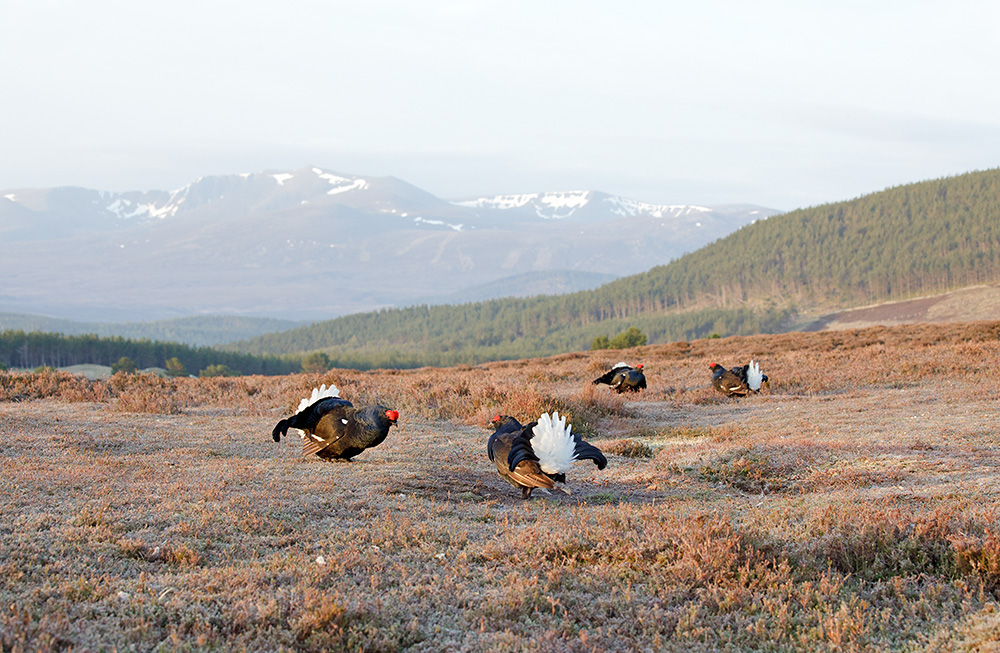
Black Grouse (Deeside, Flintshire, 26 April 2011). This evocative image shows lekking Black Grouse at their best: glossy black with bright red ‘combs’, drooped wings and prominent inflated white undertail coverts. Best of all, however, this photograph captures beautifully the dramatic settings in which these magnificent birds perform their displays. Set against a stunning mountain and moorland backdrop, a Black Grouse lek is one of Britain’s greatest bird spectacles. (David Kjaer).
Basic Principles
Many of us are focused on watching our local area, documenting the comings and goings of its birds. However much we look, though, some species are never going to occur there. These are those resident birds that are tied to particular habitats and rarely, if ever, seen away from their normal range. In Britain the classic examples are the grouse. This country hosts four species, all resident in our uplands and therefore largely birds of the north. They make admirable targets for a spring trip.
Black Grouse
This species has a large range which extends from Britain to the Russian Far East. In this country it is confined to the north and west, but throughout this range (and particularly in England and Wales) it is declining. It favours a mosaic of habitats comprising moorland with trees and scrub, bogs with rushes, young conifer plantations and birch woodland. It is best known for forming communal dawn ‘leks’ in spring at traditional sites. Although predominantly a ground-feeding bird, it is also happy to perch high in birch trees when feeding on buds.
The males (known as ‘blackcocks’) are unmistakable, particularly when seen at their spectacular and noisy ‘leks’ – glossy black with bright red ‘combs’ over the eyes, white patches in the wing, gleaming white inflated undertail coverts and a distinctive long, lyre-shaped tail. The females (known as ‘greyhens’) are much drabber, however. They are grey-brown in colour and can be confused with Red Grouse. They are slightly larger than that species, but on the ground are best identified by the lines across the closed wing formed by pale tips to the wing coverts. In flight, there is a conspicuous white wing-bar on the innerwing and a bright white underwing.
Capercaillie
Capercaillie breeds across northern and central Europe and Russia as far east as Siberia. In Britain it occurs only in east central Scotland, where it is declining. Although a native species, it was exterminated from Britain in the 18th century and the current Scottish population derives from reintroductions of Scandinavian birds in the 19th century.
This is a bird of dense coniferous woodland with an understorey of heather and Bilberry; in this country it is intimately associated with the old Caledonian pine forest. Like Black Grouse, it is known for its traditional spring ‘leks’ at which the males strut prominently and noisily. At this time of year the males can be quite aggressive and sometimes approach and even attack human intruders.
The males are magnificent and easily identified: very large and turkey-like, with a long neck, long tail and strong pale yellow bill. The plumage is black with a green-glossed breast, prominent red ‘combs’, brown wings and dark (albeit barred white) undertail coverts.
The females are much smaller than the males and might be mistaken for female Black Grouse. They are, however, still larger than that species, and stronger billed and longer tailed. The most notable plumage differences are a prominent unbarred rusty-orange patch on the breast and whitish ‘braces’ formed by pale tips to the scapulars. In flight, the upperwing is plain and the underwing not strikingly white.
Red Grouse
This is the classic British upland bird and, of the four species discussed here, the most widespread, occurring not only in Scotland but also in northern England, Wales and the South-West. It is highly resident, moving only in extreme conditions, and is closely associated with heather moorland where, in England particularly, it provides the basis for the increasingly controversial ‘sport’ of driven grouse shooting.
Britain and Ireland host the endemic subspecies scoticus, with the nominate subspecies lagopus (the circumpolar Willow Grouse, or ‘Willow Ptarmigan’ as it is known in North America) occurring right around the northern hemisphere in low Arctic habitats. The latter have white wings throughout the year and turn completely white in winter, whereas British Red Grouse are wholly dark (including the wings) and remain so throughout the year.
It is an attractive species: fat and rounded, small headed and short tailed, with feathered feet. Its plumage is a characteristic warm rusty-brown, finely barred with black and white. The males are darker, and have dark lores and a well-developed red ‘comb’ over the eye, the females being a paler, more tawny colour, more strongly barred, with paler lores and lacking a prominent comb.
Ptarmigan
The similarly circumpolar Ptarmigan (or ‘Rock Ptarmigan’ in North America) is a hardier species, occurring at higher latitudes and altitudes. In Britain it occurs only in Scotland north of the central belt, where it frequents not the mid-altitude heather moorland but the rocky ‘tundra zone’ of the country’s highest mountains. It is therefore generally easily separated from Red Grouse.
The species is well camouflaged in its alpine habitat but, when located, can be very tame and approachable. Ptarmigan is very similar to Red Grouse in structure, but slightly smaller. It is in its plumage that it differs most. Like Willow Grouse, it is white winged throughout the year, but turns wholly white (except for a dark tail) in winter. The summer body plumage is grey or brownish-grey, with fine black and white barring. In between, the birds exhibit a transitional plumage with grey and white areas mixed together.
Males have black lores (retained in winter), a well-developed red ‘comb’ and in summer are a pale grey colour. Females have pale lores (or at most a thin loral line), lack a prominent ‘comb’ and are slightly more yellowy-brown and more coarsely barred in summer.
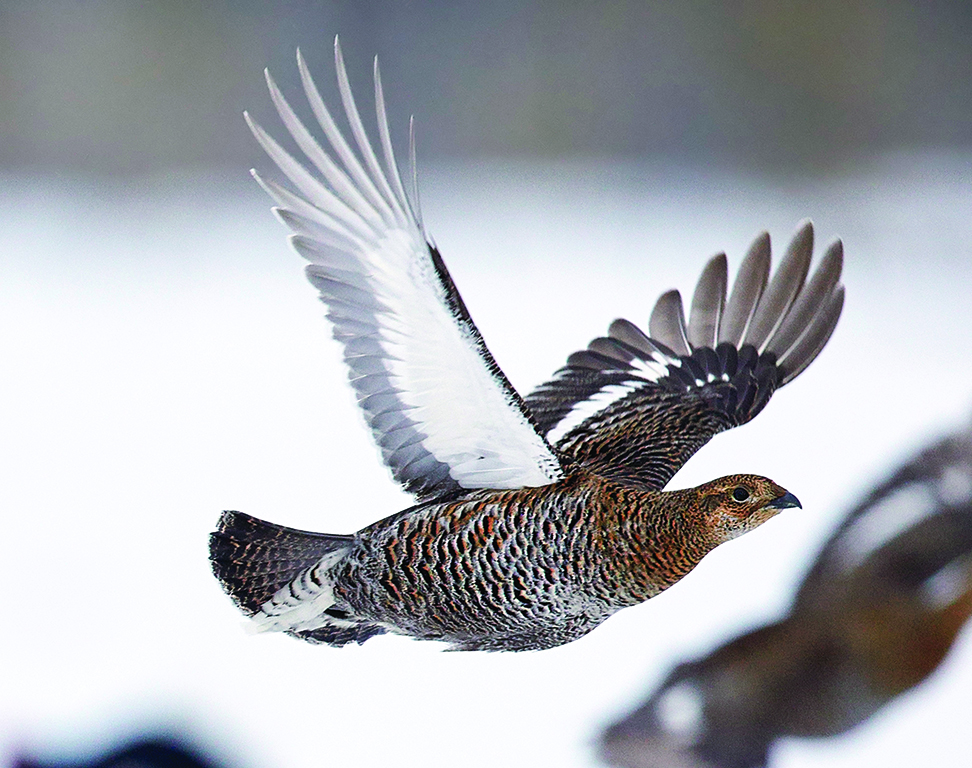
Black Grouse (Utajärvi, Finland, 6 April 2015). With its bold white wing-bar (a feature shown by no other female grouse), this flying bird is easily identified as a Black Grouse. Also visible here are a relatively short tail compared with female Capercaillie and a rather less rusty plumage colour compared with Red Grouse. Note the lack of a ‘comb’ above the eye, a feature of female grouse (Markus Varesvuo).
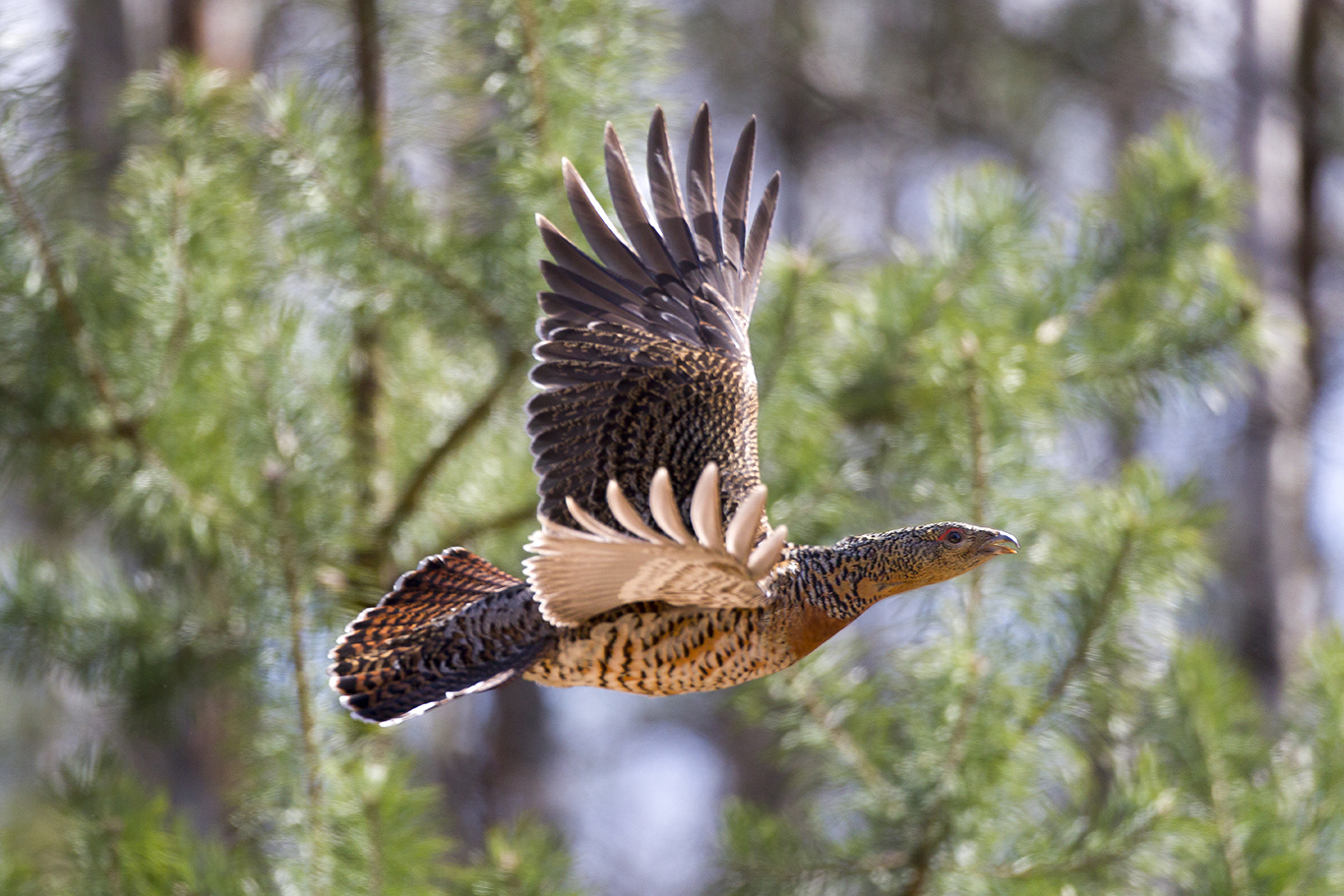
Capercaillie (Rasony, Belarus, 25 April 2012). This large and heavy-looking female grouse is a Capercaillie. The upperwing can be clearly seen here, allowing a direct comparison with the Black Grouse in the previous photo. There is no striking white wing-bar. Note here also the relatively long tail compared with female Black Grouse, the hefty bill and the prominent unmarked rusty-orange patch on the breast (Mateusz Matysiak).
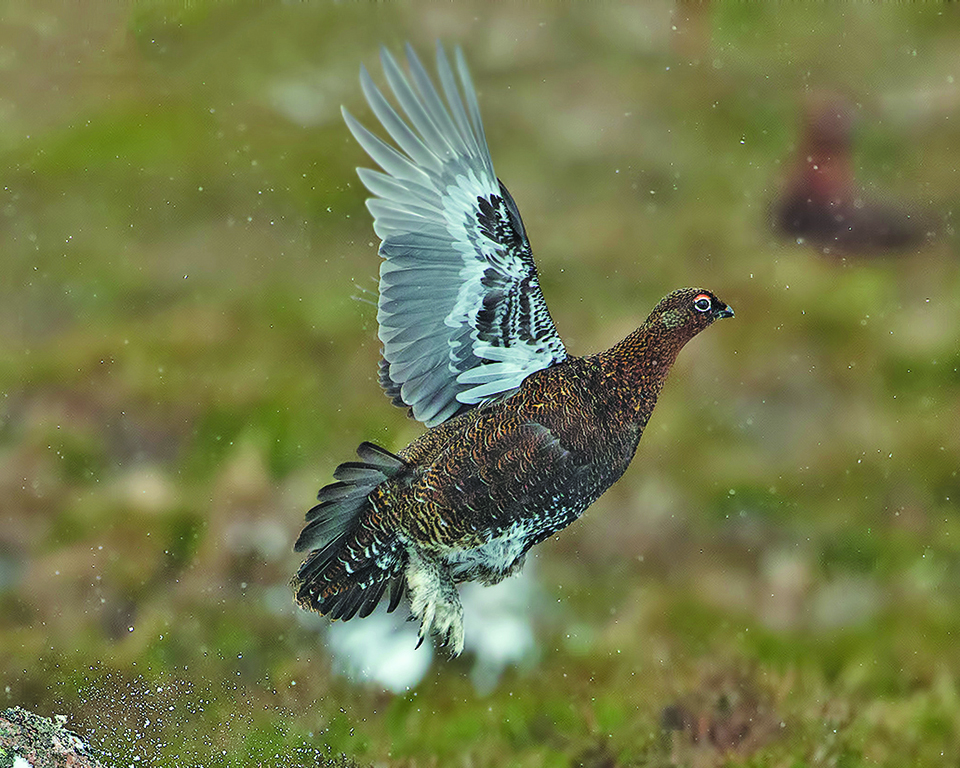
Red Grouse (Cairngorms, Highland, 15 February 2015). The beautiful dark ‘burnt umber’ hues of this bird identify it immediately as a Red Grouse. No other grouse species has these distinctive colours. Although not visible in this image, in real life the uniform upperwing, lacking a white wing-bar, would also readily exclude female Black Grouse. This bird can be sexed as a female by its lack of a prominent red ‘comb’ above the eye (Steve Hatch).
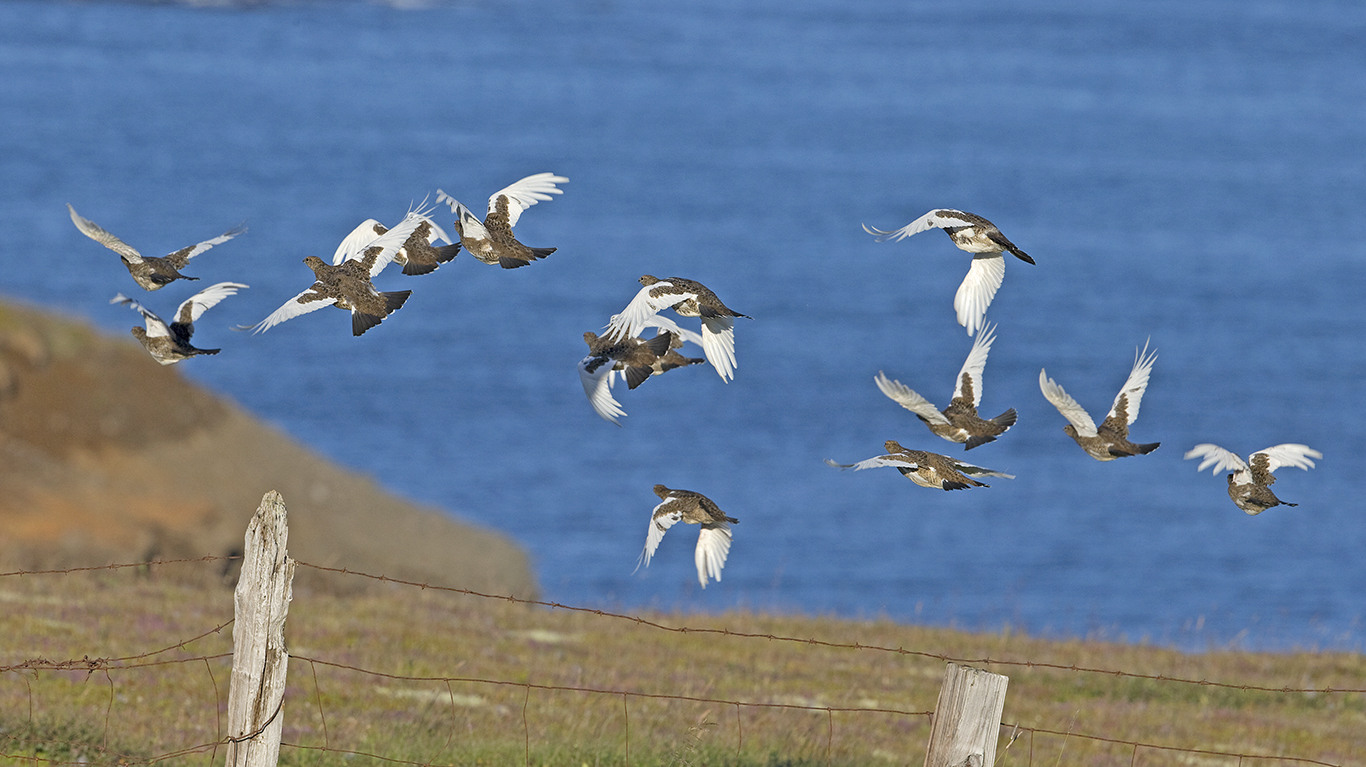
Ptarmigan (Husavik, Iceland, 18 August 2016). The mainly white wings of these fleeing birds are an immediate giveaway that they are Ptarmigan. White wings are also a field mark of continental Willow Grouse, but in Britain it is only Ptarmigan that shows this feature. The species turns wholly white in the winter, but the summer contrast, as here, between grey-brown bodies and largely white wings is perhaps even more striking Robin Chttenden / www.robinchittenden.co.uk).
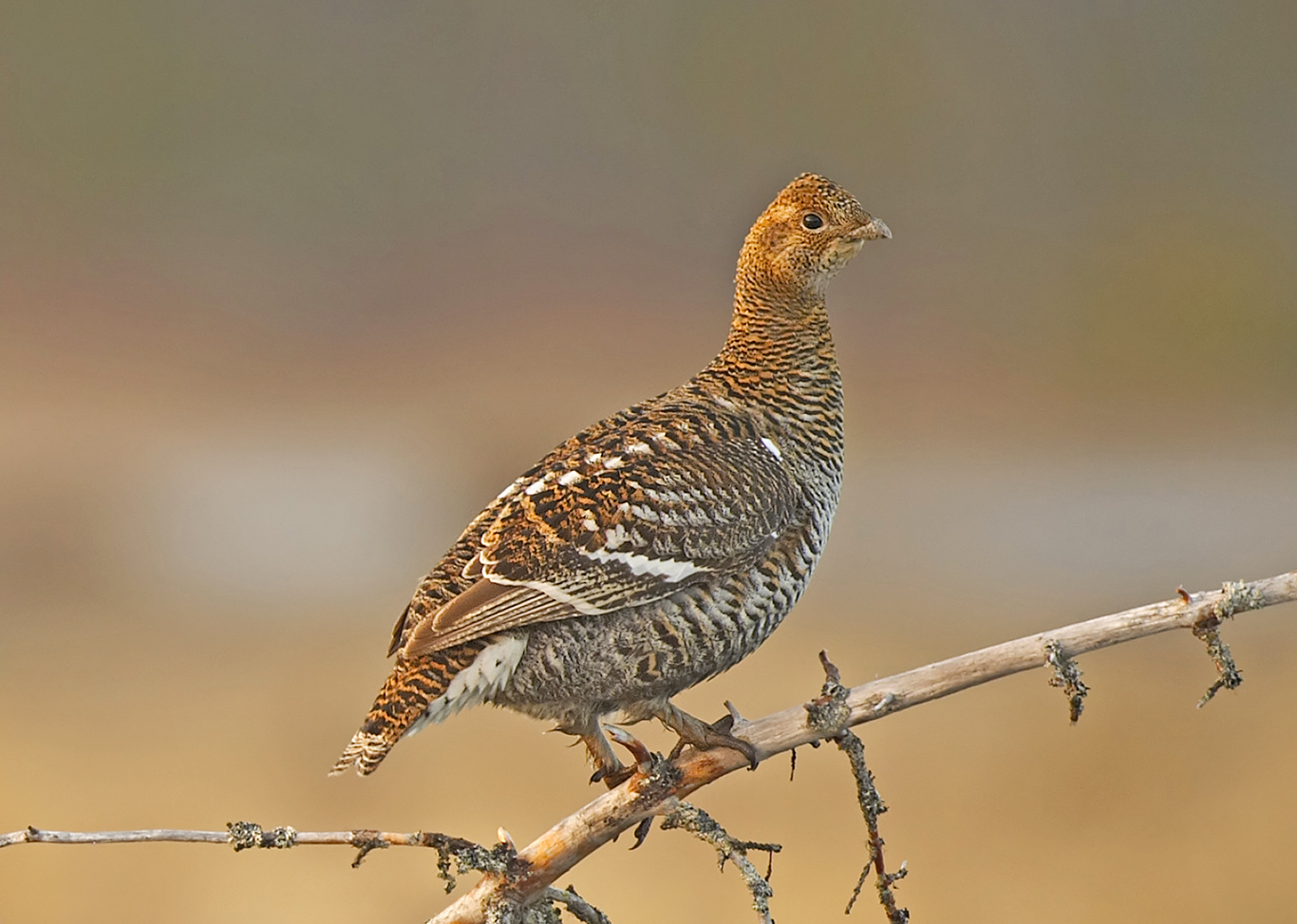
Black Grouse (Kuusamo, Finland, 8 May 2004). This lovely portrait captures beautifully the tree-perching habit of Black Grouse. In terms of its identification, the white bars across the closed wing, the short tail and the wholly barred underparts (including the chest) are, in combination, sufficient to rule out both Red Grouse and Capercaillie (Markus Vaesvuo).
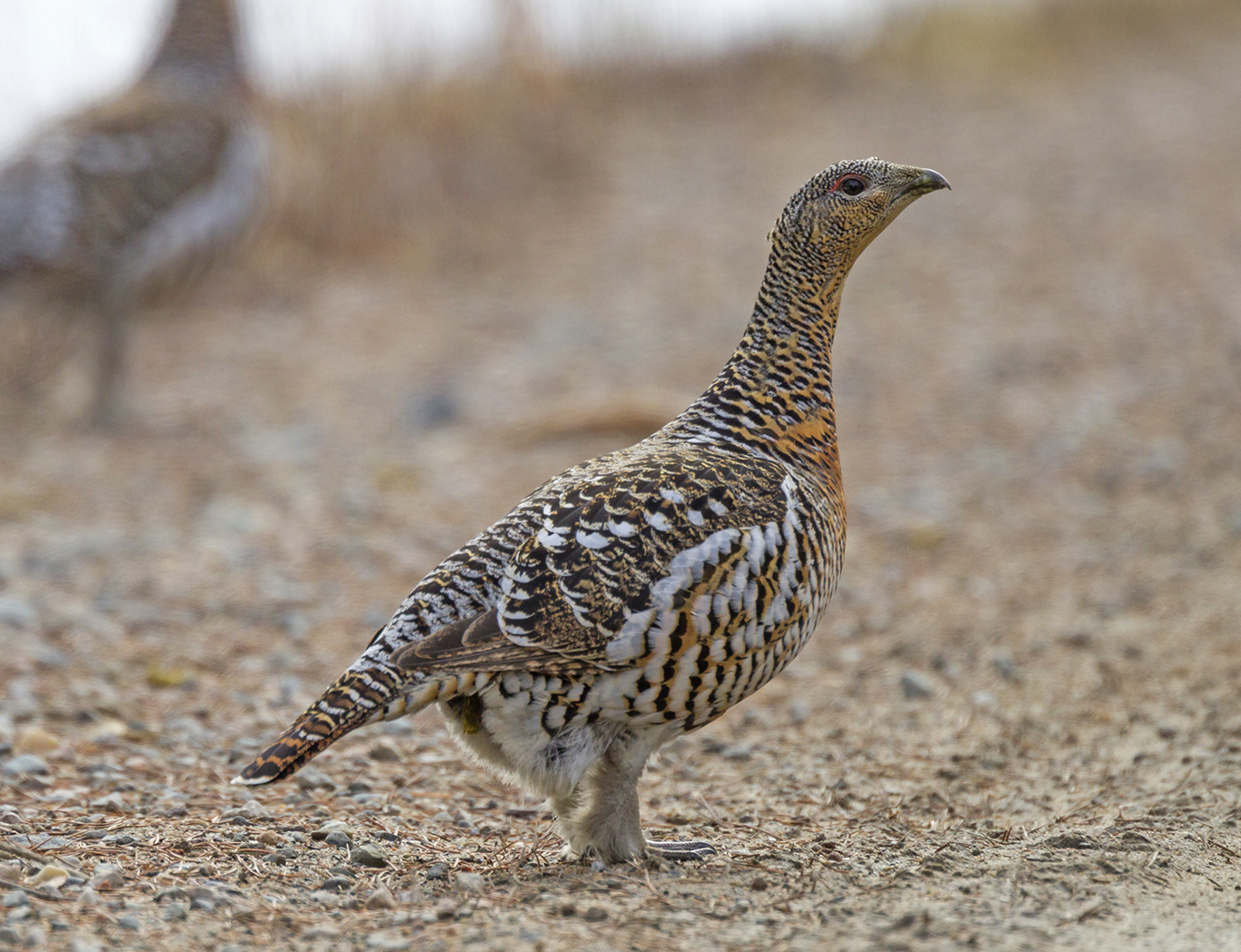
Capercaillie (Kuusamo, Finland, 22 April 2011). This large, assertive-looking grouse is a female Capercaillie, easily identified as such by its relatively long tail and (just visible here) the contrasting rusty-orange patch on the breast. Note also the relatively strong bill compared with that of Black Grouse (Oliver Smart / www.smartimages.co.uk).
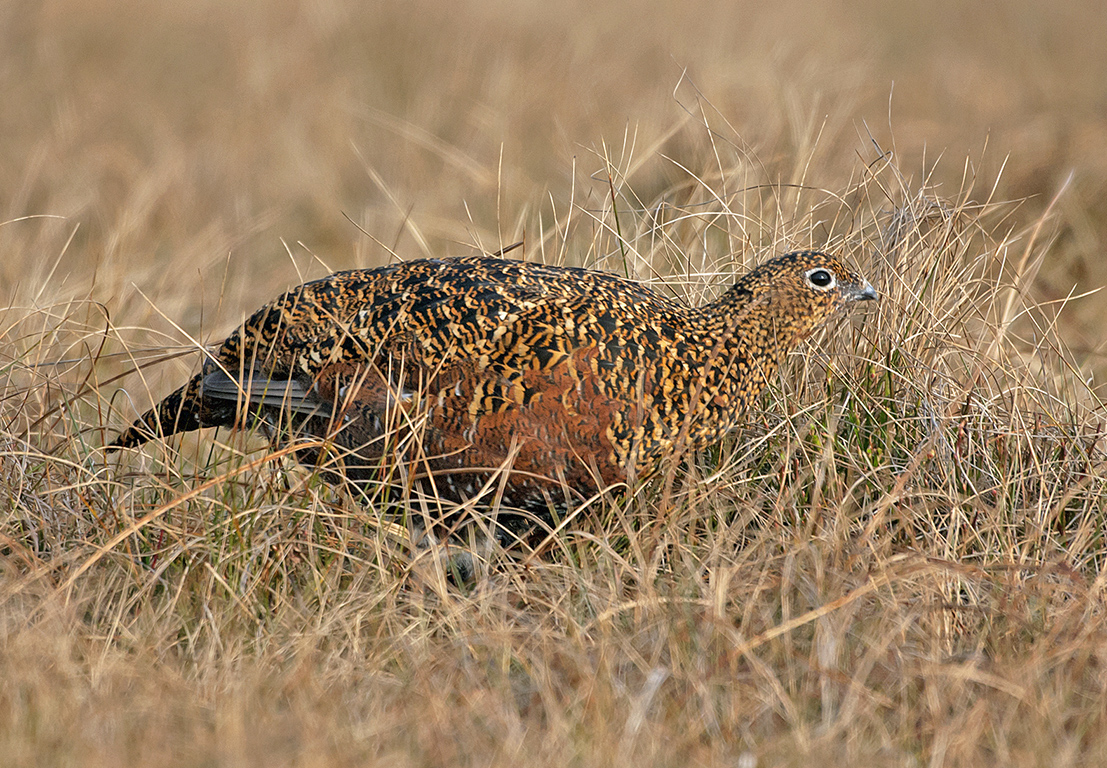
Red Grouse (Cheshire Moors, Cheshire, 14 April 2007). The lack of white bars across the wing, the dark flight feathers, the short tail and the absence of an unmarked rusty-orange breast patch all identify this bird as a Red Grouse, while the lack of a bright red comb confirms it as a female. Although traditionally associated with heather moorland, this species can also frequent (as here) rough grassland habitat (Steve Young / www.birdsonfilm.com).
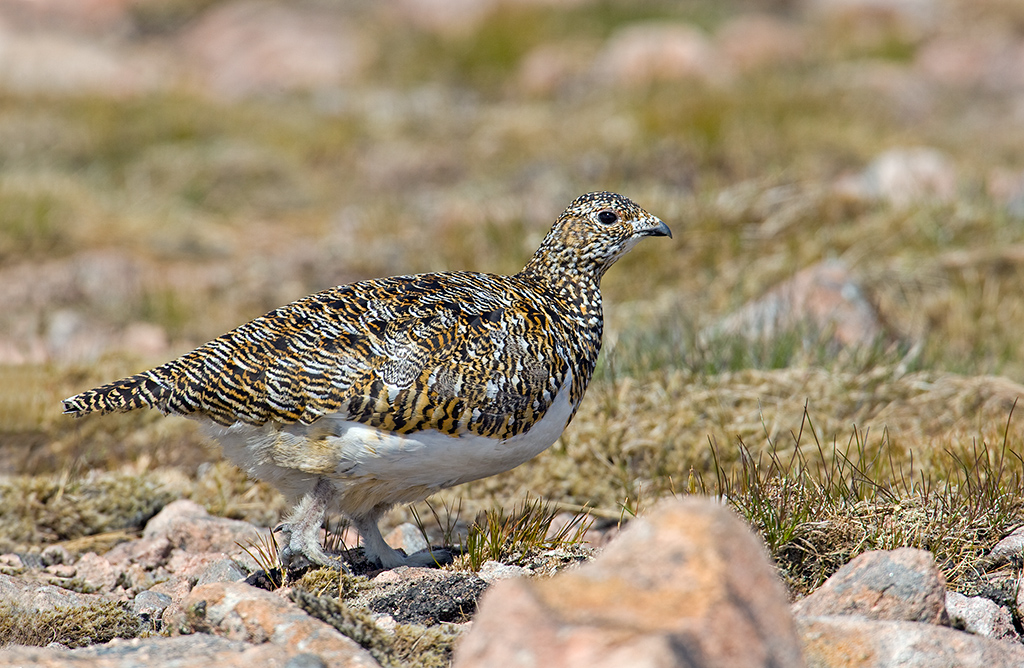
Ptarmigan (Cairngorms, Highland, 24 May 2008). The white underparts quickly identify this bird as a Ptarmigan, but note also the beautiful grey hues in the intricately marked upperparts – a clear echo of the rocky alpine habitats in which it is always found, although in the west of its Scottish range it does occur at lower altitudes. Note again the lack of a red comb on this female bird (David Kjaer).
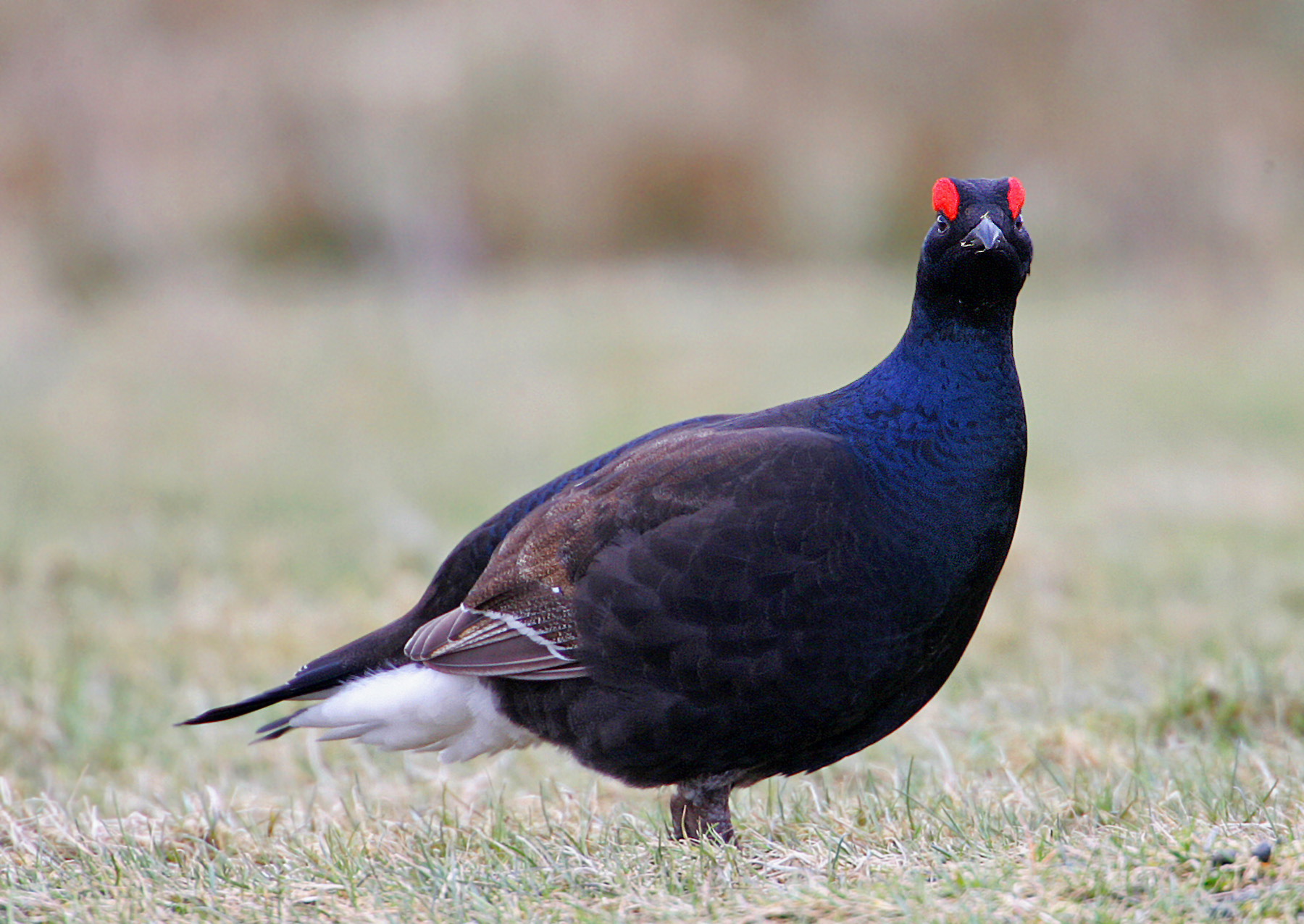
Black Grouse (Haydon Bridge, Northumberland, 2 April 2006). Even when not displaying at a lek, male Black Grouse are both stunning and unmistakable. Note the beautiful blue gloss to the black plumage, the relatively long tail, the brilliant red combs and the striking white undertail coverts (Bill Baston).
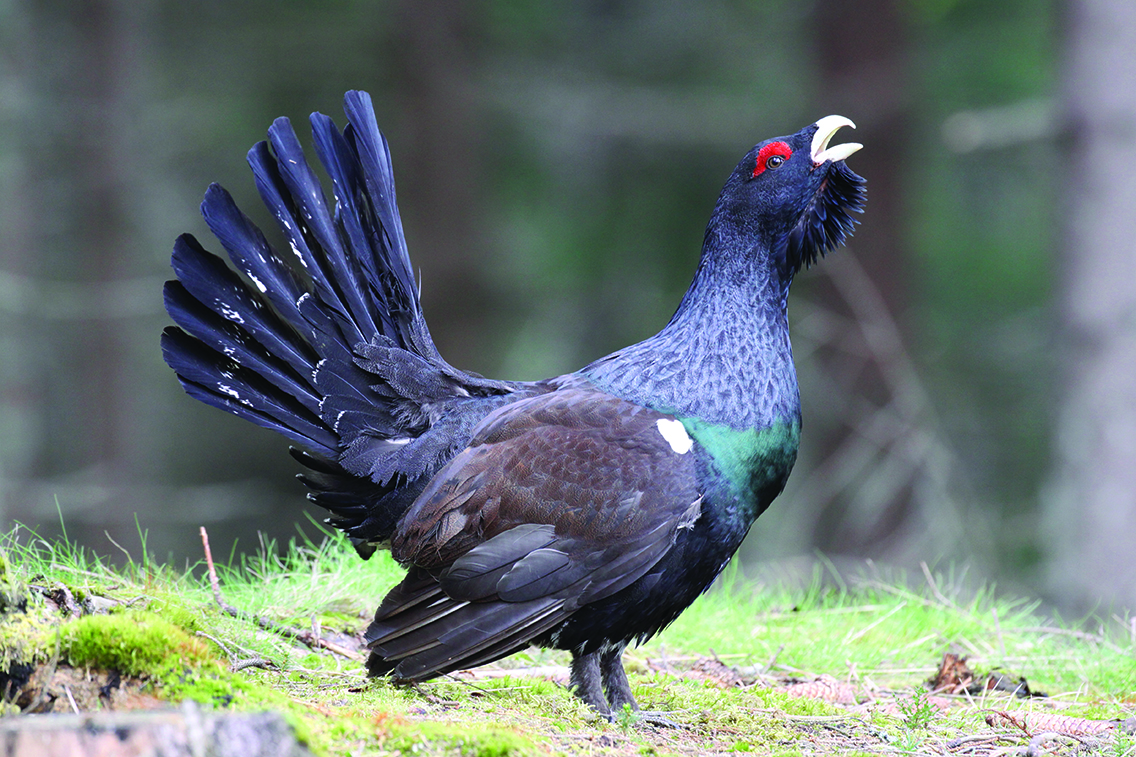
Capercaillie (Skövde, Sweden, 9 May 2009). With its raised and fanned tail and bristling throat feathers, a lekking male Capercaillie is an impressive sight indeed. Note the length of the tail, the great size of the bill, the glossy green patch on the breast and of course the bright red combs (Chris van Rijswijk / www.agami.nl).
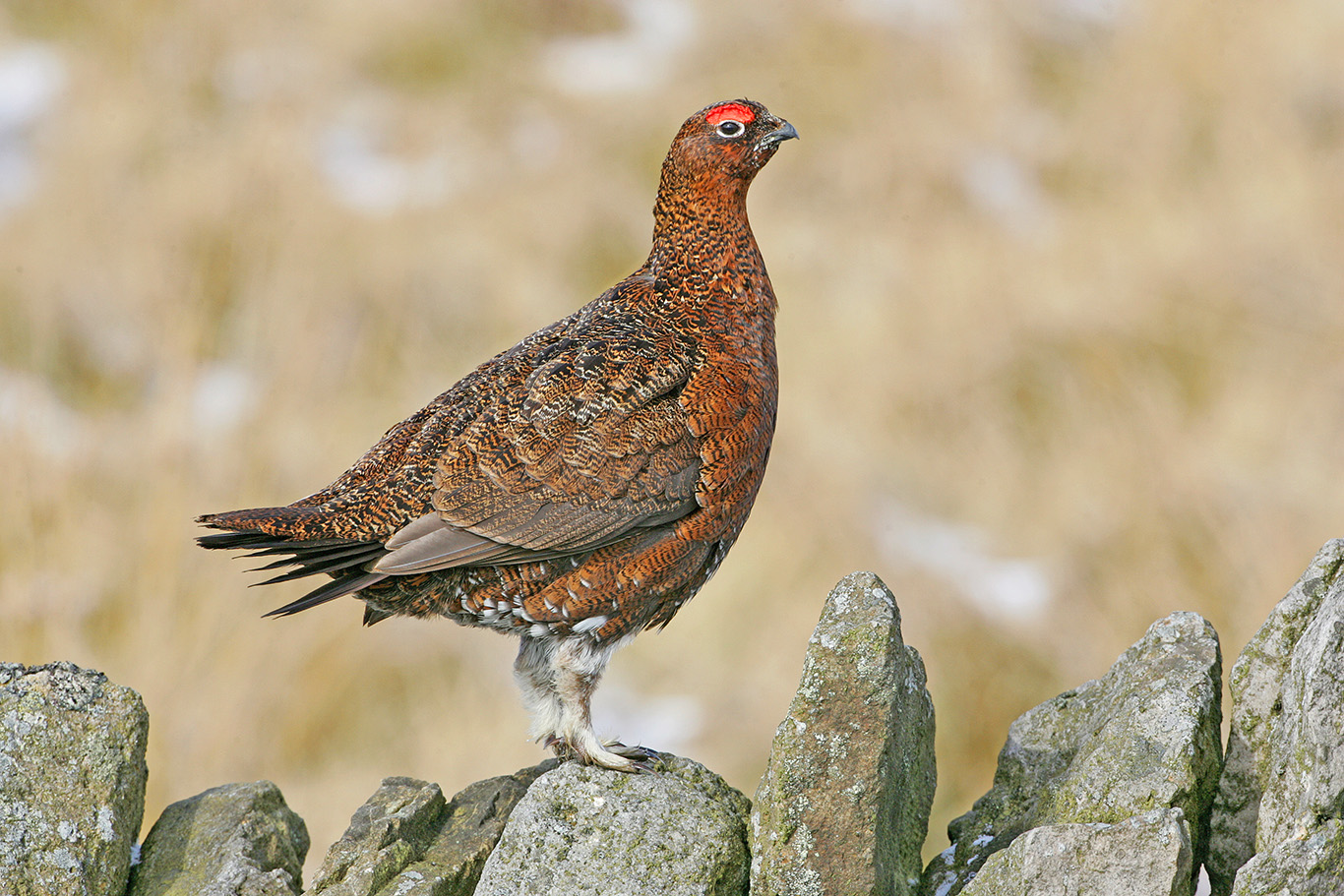
Red Grouse (Haydon Bridge, Northumberland, 4 April 2006). This brightly combed male Red Grouse is showing to perfection the gorgeous deep russet hues in its head and body plumage. Note also its short tail, dark flight feathers and lack of white bars across the wing. Posed like this, it is also possible to appreciate the highly intricate pattern of each individual feather (Bill Baston).
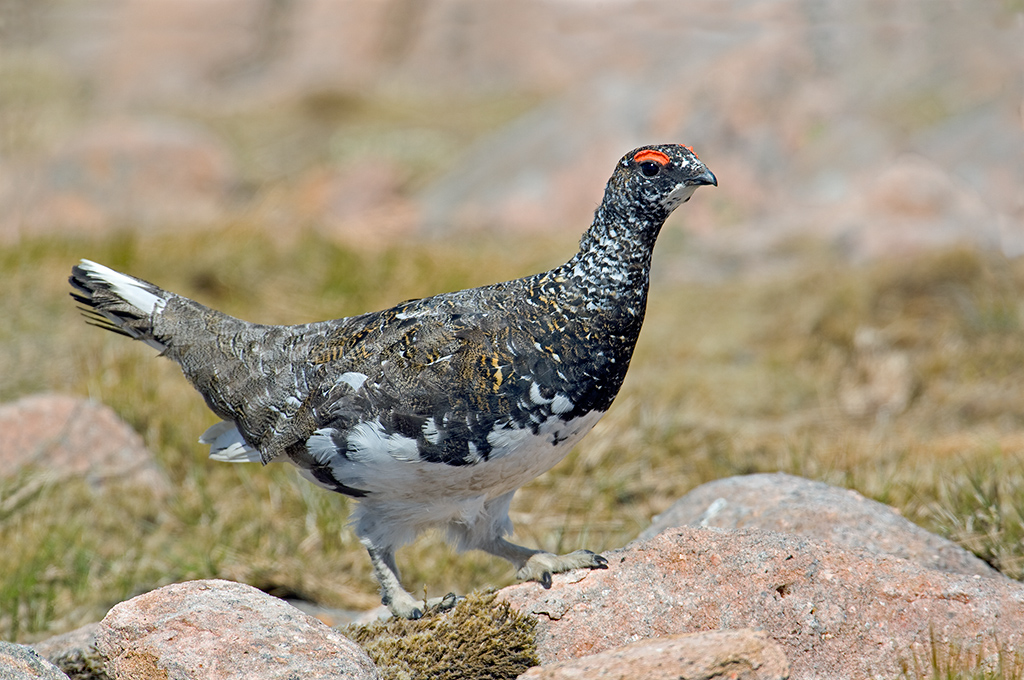
Ptarmigan (Cairngorms, Highland, 24 May 2008). The grey upperparts and white underparts (and the rocky habitat) immediately identify this as a Ptarmigan, while the red combs confirm that it is a male. Note again, as indeed in all the grouse, the supremely delicate and complex markings on the head and body feathers (David Kjaer).
Where to find your own
All of our native grouse species are sedentary, and you should be able to find them within range with luck and patience.
Black Grouse is found in moorland habitats in upland areas of North Wales, the Lake District, the Pennines and the Yorkshire Dales, but the species’ major stronghold is Scotland, where it is sparsely distributed in all upland areas. There are remnant north-eastern populations in Kielder Forest Park and Northumberland National Park, as well as a reintroduction programme in the Peak District. The RSPB run early morning trips to see lekking birds in spring – the best time to see them – at Coed Llandegla Forest, Denbighshire (SJ 2251), Geltsdale, Cumbria (NY 5957), Schiehallion, Perthshire (NN 7154), and several other sites.
Capercaillie is solely restricted to areas of mature Caledonian forest in the eastern Highlands. Again, the RSPB operates guided visits to see the species, most notably at Loch Garten RSPB, Highland (NJ 0216). Despite being reintroduced, Capercaillie is in a perilous position in Britain and other sites are not advertised.
Red Grouse is widespread in the same uplands as Black Grouse, with additional small pockets in south Wales and on Dartmoor, Devon (SX 5780). It is most numerous at sites where the population is managed for shooting and, while you would be wise not to trespass, public footpaths do cross most managed heather moors.
Ptarmigan occurs mainly in the highest parts of the Grampians and north-west Highlands. The ski car park and restaurant at Cairngorm (NJ 0004), Carn Ban Mor (NN 8997), Glenshee (NO 1378) and Applecross (NG 7144) – all Highland – are the most famous and productive sites, but winter-plumaged birds are the hardest to see as the roads may become impassable at that time of year.
- This article was originally published in the May 2017 edition of Birdwatch.







